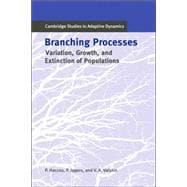
Note: Supplemental materials are not guaranteed with Rental or Used book purchases.
Purchase Benefits
What is included with this book?
| Authors | p. ix |
| Acknowledgments | p. x |
| Notational Standards | p. xii |
| Generalities | p. 1 |
| The Role of Models | p. 2 |
| The Role of Randomness | p. 4 |
| Branching Processes: Some First Words | p. 6 |
| Stochastic and Deterministic Modeling: An Illustration | p. 7 |
| Structure of the Book | p. 10 |
| Discrete-Time Branching Processes | p. 11 |
| The Basic Process | p. 13 |
| Basic Properties and Two Benchmark Processes | p. 16 |
| Several Types | p. 21 |
| Generation Overlap | p. 31 |
| State Dependence | p. 36 |
| Dependence on the Population Itself | p. 38 |
| Interaction Between Individuals | p. 42 |
| Sexual Reproduction | p. 43 |
| Varying Environments | p. 46 |
| Migration | p. 52 |
| Branching in Continuous Time | p. 56 |
| Generations in Real Time | p. 56 |
| Reproducing Only Once | p. 59 |
| General Branching Processes | p. 66 |
| Age-distribution and Other Composition Matters | p. 79 |
| Interaction, Dependence upon Resources, Varying Environment, and Population | p. 81 |
| Large Populations | p. 82 |
| Approximations of Branching Processes | p. 82 |
| Discrete-Time Dynamical Systems as Population Models | p. 88 |
| Branching Processes and Structured Population Dynamics | p. 94 |
| Extinction | p. 107 |
| The Role of Extinction in Evolution | p. 107 |
| Extinction or Explosion: The Merciless Dichotomy | p. 108 |
| Extinction and Generating Functions | p. 110 |
| Time to Extinction in Simple Processes | p. 115 |
| Multi-type Processes | p. 122 |
| Slightly Supercritical Populations | p. 124 |
| Accounting for Time Being Continuous | p. 130 |
| Population Size Dependent Processes | p. 133 |
| Effects of Sexual Reproduction | p. 135 |
| Environmental Variation Revisited | p. 145 |
| Development of Populations | p. 153 |
| Exponential Growth | p. 154 |
| Asymptotic Composition and Mass Growth | p. 161 |
| Reproductive Value | p. 165 |
| Populations Bound for Extinction | p. 167 |
| Interaction and Dependence | p. 170 |
| Growth of Populations with Sexual Reproduction | p. 177 |
| Immigration in Subcritical Populations | p. 179 |
| Quasi-stationarity: General Remarks | p. 183 |
| Quasi-stationary Behavior in a Simple Discrete-time Model | p. 190 |
| Specific Models | p. 200 |
| Coalescent Processes: Reversed Branching | p. 200 |
| Ancestral Inference in Branching Processes | p. 208 |
| The Cell Cycle | p. 218 |
| Telomere Shortening: An Overview | p. 225 |
| The Polymerase Chain Reaction | p. 231 |
| Modeling Measles Outbreaks | p. 236 |
| Metapopulations | p. 249 |
| Multi-type Branching Processes and Adaptive Dynamics of Structured Populations | p. 266 |
| Appendix | p. 278 |
| Expectation and Variance | p. 278 |
| Useful Equalities and Inequalities | p. 280 |
| Conditioning | p. 283 |
| Distributions and Their Transforms | p. 284 |
| Convergence | p. 290 |
| The Perron-Frobenius Theorem | p. 293 |
| References | p. 295 |
| Index | p. 307 |
| Table of Contents provided by Ingram. All Rights Reserved. |
The New copy of this book will include any supplemental materials advertised. Please check the title of the book to determine if it should include any access cards, study guides, lab manuals, CDs, etc.
The Used, Rental and eBook copies of this book are not guaranteed to include any supplemental materials. Typically, only the book itself is included. This is true even if the title states it includes any access cards, study guides, lab manuals, CDs, etc.